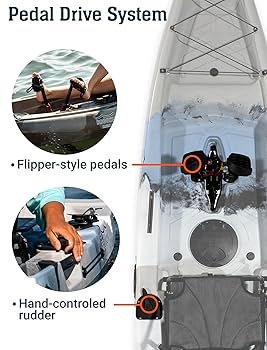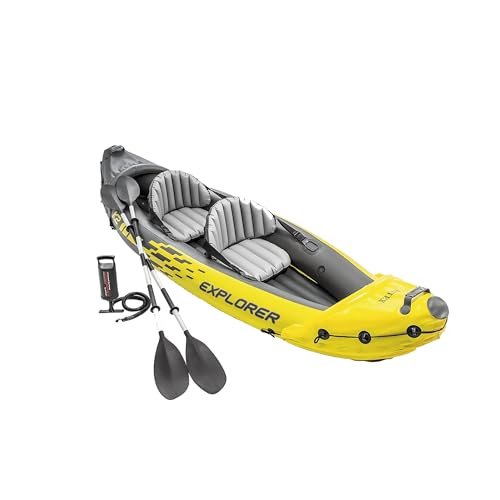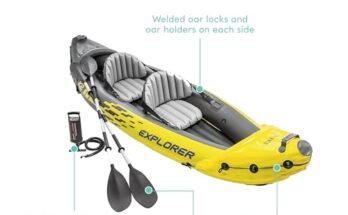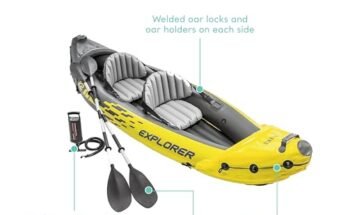Have you ever wondered how kayak pedals actually work to make your paddling easier and more efficient? Understanding this simple yet clever mechanism can transform the way you navigate the water.
Whether you’re a beginner or looking to improve your kayaking skills, knowing how your kayak pedals function gives you better control and power. You’ll discover exactly how these pedals help you move smoothly, save energy, and enjoy your time on the water even more.
Keep reading to unlock the secrets behind your kayak pedals and take your adventure to the next level.
Basics Of Kayak Pedal Systems
Kayak pedal systems help paddlers move hands-free. They use foot pedals to power movement.
Understanding how these pedals work can improve your kayaking experience. Let’s explore the basics.
Types Of Pedal Mechanisms
Kayak pedal systems come in different designs. Each type moves the kayak differently.
- Direct Drive:Pedals connect directly to a propeller or fins.
- Chain Drive:Pedals turn a chain that moves the propeller.
- Belt Drive:Pedals use a belt system to power the propulsion.
- Gear Drive:Pedals engage gears to spin the propeller faster.
Components Involved
A kayak pedal system has several key parts. Each part works to create smooth movement.
| Component | Function |
| Pedals | Where you place your feet to push |
| Drive Mechanism | Transfers pedal motion to the propeller |
| Propeller or Fins | Push water to move the kayak |
| Frame | Holds the system in place inside the kayak |
How Pedals Drive Propulsion
When you push the pedals, the drive mechanism turns the propeller. This pushes water backward.
The key actions include:
- Pedals move with your feet.
- The drive system converts pedal motion.
- The propeller spins to push water.
- The kayak moves forward.

Benefits Of Pedal-powered Kayaking
Pedal-powered kayaks use foot pedals to move through the water. This system lets kayakers use their legs to paddle instead of their arms.
Using pedals offers many benefits. It makes kayaking easier and more efficient in different water conditions.
Hands-free Navigation
Pedal-powered kayaks free your hands from paddling. You can steer or control the kayak while pedaling.
This allows you to use your hands for fishing, taking photos, or adjusting equipment. It makes your trip more enjoyable and practical.
Increased Speed And Efficiency
Leg muscles are stronger than arm muscles. Using pedals lets you use more power to move faster.
Pedal systems keep a steady speed with less effort. This helps you cover more distance without getting tired quickly.
Enhanced Stability On Water
Pedaling helps keep your body balanced. It lowers the chance of tipping over in rough water.
Using pedals keeps your center of gravity stable. This makes it easier to stay upright and enjoy your kayak trip safely.
Using Kayak Pedals Effectively
Kayak pedals help you steer without using your hands. Using them well makes your trip smoother and safer.
Learn how to place your feet, adjust pedal tension, and move pedals with your paddle. These tips improve control.
Proper Foot Placement
Keep your feet flat on the pedals for better grip. Avoid placing your toes or heels on the edges.
Place your feet so you can press pedals easily without straining. This helps you steer quickly.
- Keep feet centered on pedals
- Use the ball of your foot to press
- Adjust foot position if you feel discomfort
Adjusting Pedal Tension
Pedal tension controls how hard you press to turn. Set it to a level that feels comfortable for you.
Tighter tension gives more precise control but needs more effort. Looser tension is easier but less responsive.
- Try different tension settings before paddling
- Choose tension that suits your strength
- Adjust tension if you feel tired or lose control
Coordinating Pedal And Paddle Movements
Use your pedals and paddle together to move straight or turn smoothly. Timing is important.
Press pedals to steer while paddling on the opposite side. This balances your kayak’s movement.
- Press right pedal and paddle on left side to turn right
- Press left pedal and paddle on right side to turn left
- Use gentle pedal pressure for small turns
- Combine strong pedal and paddle strokes for sharp turns
Maintenance Tips For Pedal Systems
Kayak pedals help you move smoothly and control your direction. Keeping them in good shape is key to enjoying your time on the water. Simple care steps can make pedals last longer and work better.
This guide covers cleaning, checking for damage, and storing pedals safely during off-season.
Regular Cleaning And Lubrication
Clean pedals after each use to remove dirt, sand, and salt. Use fresh water and a soft brush. Dry them well before applying lubricant. Lubricate moving parts to keep them smooth and prevent rust.
- Rinse pedals with fresh water
- Use mild soap if needed
- Dry pedals completely
- Apply silicone-based lubricant
- Wipe off excess lubricant
Inspecting For Wear And Tear
Check pedals regularly for signs of damage. Look for cracks, loose screws, or worn parts. Replace any broken or weak components to avoid failures while kayaking.
| Part | What to Look For | Action Needed |
| Pedal surface | Cracks or rough spots | Replace if damaged |
| Bearings | Noise or stiffness | Clean and lubricate or replace |
| Bolts and screws | Loose or missing | Tighten or replace |
| Pedal arms | Bends or breaks | Inspect and replace if needed |
Storing Pedals During Off-season
Store pedals in a dry, cool place away from sunlight. Remove them from the kayak if possible. Cover pedals to protect from dust and moisture. Check them before next use.
- Clean and dry pedals before storage
- Remove pedals if detachable
- Store in a sealed container or bag
- Keep away from direct sunlight and heat
- Inspect pedals before next trip
Choosing The Right Kayak Pedal System
Kayak pedals help you move and steer your kayak using your feet. Picking the right pedal system makes paddling easier and more fun.
Different kayaks need different pedals. Think about your kayak type, the materials used, and your budget before buying pedals.
Matching Pedals To Kayak Types
Not all pedals fit every kayak. Some kayaks work better with specific pedal systems. Choose pedals that fit your kayak’s design.
For sit-on-top kayaks, pedals with easy footrests work well. Sit-inside kayaks may need pedals with adjustable straps for comfort.
- Recreational kayaks: simple pedal systems are enough
- Fishing kayaks: pedals with strong control help maneuver
- Touring kayaks: lightweight pedals improve speed and comfort
Evaluating Durability And Materials
Pedals face water, sun, and rough use. Durable materials last longer and need less repair. Look for rust-proof and tough materials.
Plastic pedals are light and cheap but may wear out fast. Metal pedals are stronger but heavier. Some pedals mix plastic and metal for balance.
- Stainless steel parts resist rust
- High-quality plastics handle impact and sun
- Rubber grips prevent slipping
Budget Considerations
Pedal systems come in many price ranges. Set a budget before shopping. Cheaper pedals may work for casual use.
Expensive pedals often offer better durability and comfort. Think about how often you kayak and what features you need before paying more.
- Low budget: basic pedals for light use
- Mid-range: good balance of quality and price
- High-end: best materials and features for frequent use


Frequently Asked Questions
How Do Kayak Pedals Control Direction?
Kayak pedals connect to a rudder system. By pushing pedals forward or backward, you steer the kayak. This allows precise control without using paddle strokes. It helps in maintaining a straight course or making sharp turns efficiently.
What Powers The Movement Of Kayak Pedals?
Pedals are powered by your feet. When you pedal, it turns a gear or cable system linked to the rudder. This action moves the rudder, steering the kayak. It provides hands-free directional control, improving kayaking comfort and ease.
Can Kayak Pedals Improve Paddling Efficiency?
Yes, kayak pedals enhance paddling efficiency. They allow steering without interrupting your paddle strokes. This reduces arm fatigue and improves speed. Pedals help maintain balance and control, making long trips more comfortable and less tiring.
Are Kayak Pedals Easy To Use For Beginners?
Yes, kayak pedals are beginner-friendly. They require minimal effort to operate and offer intuitive steering control. Beginners can quickly learn to maneuver without complex techniques. This makes kayaking accessible and enjoyable for all skill levels.
Conclusion
Kayak pedals help you move your kayak using your feet. They connect to a system that turns your pedaling into paddle movement. This lets you steer and go forward without using your hands. Pedals make kayaking easier and more comfortable.
Understanding how they work helps you enjoy your time on the water. Give them a try to see the difference yourself. Simple, smooth, and effective.



